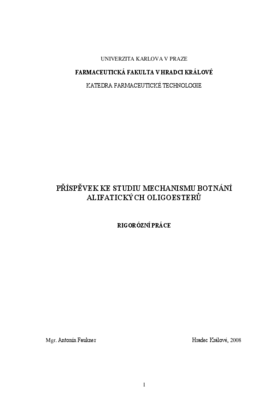Příspěvek ke studiu mechanismu botnání alifatických oligoesterů
The contribution to the study of the swelling mechanism of aliphatic oligoesters
rigorous thesis (DEFENDED)

View/
Permanent link
http://hdl.handle.net/20.500.11956/19315Identifiers
Study Information System: 64414
CU Caralogue: 990010104770106986
Collections
- Kvalifikační práce [6885]
Author
Advisor
Referee
Šnejdrová, Eva
Faculty / Institute
Faculty of Pharmacy in Hradec Králové
Discipline
Pharmacy
Department
Department of Pharmaceutical Technology
Date of defense
14. 10. 2008
Publisher
Univerzita Karlova, Farmaceutická fakulta v Hradci KrálovéLanguage
Czech
Grade
Pass
Souhrn V práci se pojednává o interakci oligoesterových nosičů, založených na kopolymeru kyseliny DL-mléčné a glykolové, s hydrofilním médiem. Výsledkem interakce jsou jevy degradace, eroze a botnání nosiče. Cílem práce bylo stanovit ve vodě rozpustné, výrazně osmoticky aktivní degradační produkty vzniklé hydrolýzou v matricích a nalézt souvislost mezi jejich koncentrací a změnami botnání v závislosti na čase. Experimenty proběhly se dvěma druhy větvených polymerů, které se lišily koncentrací tripentaerythritolu použitého jako větvící monomer a přítomností 20 % triethylcitrátu ve funkci plastifikátoru. Testované matrice se lišily též hmotností. Metoda zahrnovala gravimetrické sledování eroze a botnání matric a alkalimetrické stanovení kyselých degradačních produktů, které byly získány rozdělením hydrofilních a lipofilních frakcí matrice mezi organickou a vodnou fázi. Byla prokázána těsná korelace mezi botnáním matric a koncentrací v nich obsažených hydrofilních oligoesterů.
This work deals with interaction of oligoester carriers based on DL-lactic-co-glycolic acid, with hydrophilic medium. The interaction results with phenomena of degradation, erosion and swelling of delivery system. The purpose of this work was to quantify water soluble, high osmotically active degradation products generated via hydrolysis in the matrices, and to find a connection between concentration of degradation products and changes of swelling in time. Experiments with two types of branched polymers were realized. The main difference between the both had origin in the concentration of tripenterythritol used as branching monomer and in the blending of this polymer with 20% triethylcitrate used as plasticizer. Matrices differ in size too. The method used included parallel gravimetric monitoring of erosion and swelling of matrices and alkalimetric quantifying of degradation acid hydrolysis products. The last mentioned parameter was obtained by the separation of hydrophilic and lipophilic fractions of matrices between organic and aqueous phase. Narrow correlation between matrices swelling rate and simultaneously proven concentration of hydrophilic oligoesters generated in matrices was established.
